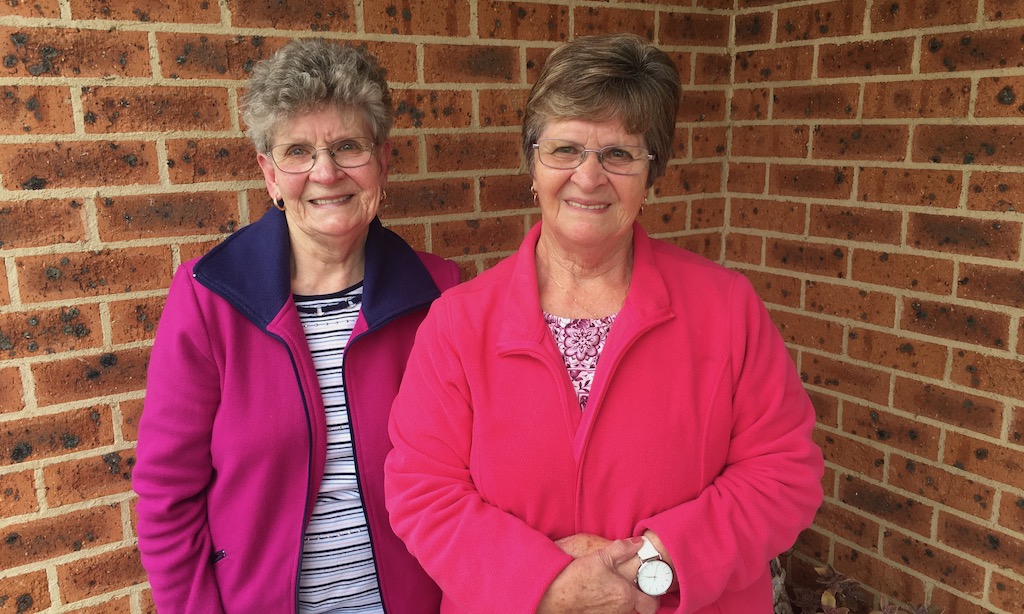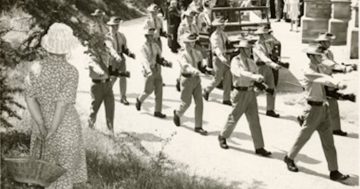
Single-level terraces in Clifford Street, near Ellesmere Street which had a similar style of housing. These were built about 1850 and have since been demolished. Photo: History Goulburn.
Inner-city housing is gradually returning to Goulburn, but is a far cry from the enclaves that sprang up around businesses in the 1960s. One such place was Ellesmere Street, where growing families almost burst onto the footpaths out the front of terraced cottages.
The Cox family of nine girls and two boys squeezed into the street’s biggest home, of four bedrooms with a bathroom out the back. Margaret had the job of cutting wood for the fuel stove in the kitchen, which ultimately led to her future husband. First, though, was cutting the wood, for the stove, a copper for washing and a chip heater in the outside bathroom where the kids hopped into the bath one after the other.
Their father, Keith, a railway fettler who later became a ganger, had moved with the family from Manildra in 1960 to a tent in North Goulburn for 14 months. In her early teens, Margaret was happy to move to Ellesmere Street, even though three girls shared a double bed, and two others slept on either end of a single bed, all in the one bedroom.
“We could just walk down the street. We walked into Auburn Street, at Levantis Brothers shop we used to get ice cream of a night,” Margaret said. “Ray (her brother) and I went to the midnight shows together at Hoyts and the Odeon.”
Called up to serve in Vietnam, Ray returned home for a surprise visit, announcing his arrival by rocking their iron roof. They were all thrilled to see him. Sadly, he was killed in action later, after triggering a booby trap. He had only six weeks remaining of his service.
Next to the Coxes, Joe Storrier ran the Esso service station, and Terry ”Shadow” Hartnett had a panel-beating business out the back. Max Mortimer, a young panel beater who had moved to Goulburn from Crookwell and later worked for Shadow, was drawn to the sound of the wood chopping next door and became even more interested in Margaret. Their over-the-fence conversations led to their marriage in 1970.

Sisters Joy Taylor and Margaret Mortimer, who have fond memories of growing up in Ellesmere Street. Photo: John Thistleton.
On the other side of Storrier’s service station, Ken and Marg Staines spent the first two years of their married life in a two-bedroom terrace, one of four in the block.
“No sink in the kitchen, no water, you washed up in a dish,” Margaret said. “There was a fuel stove in the kitchen, a Warmray in the lounge room. We had a huge backyard and beautiful soil.”
Ken said a single power point served the entire house. “We had a lead going out to the laundry to the washing machine; it always gave us a shock.”
They raised two daughters, Julie and Leeanne.
“We were just married. We were battling, but we were happy for sure. We didn’t have much money, but we had no worries either,” Ken said.
He walked past the Department of Main Roads depot on his way to work at Wally Lambert’s spray-painting shop.
“Wally started there painting sulkies before he went into cars,” Ken said.
When Joe Storrier was injured and ended up in hospital, neighbours including Ken pumped petrol for him. “They were a nice lot of people around there,” Ken said.
Steele’s Cordial factory operated on the corner on the opposite side of where Lincoln Paints later established a paint and hardware shop.
“I used to like their crinkly orange and they made hop ale,” Ken said. “They only made it at different times of the year, but you could smell it. It was so nice.”

Stella Cox outside the family home in Ellesmere Street, Goulburn. Photo: Cox family.
Steele’s had closed by the time Bob Kirk, who lived around the corner in Clifford Street, skylarked in the empty building with his young teenager mates in the mid-1960s. He lived in a two-storey terrace and remembers others like it, little stone cottages and houses and sheds, and numerous families living above shops around the CBD. The Kirks had previously lived above a shop in Russell Lane.
Art plasterers, road workers, spray painters, panel beaters and cordial makers plied their trade in Ellesmere over the years, before buildings were demolished to make way for car parking.
All that bitumen and those cars cover an extraordinary snapshot of life in Goulburn in the 1960s.








